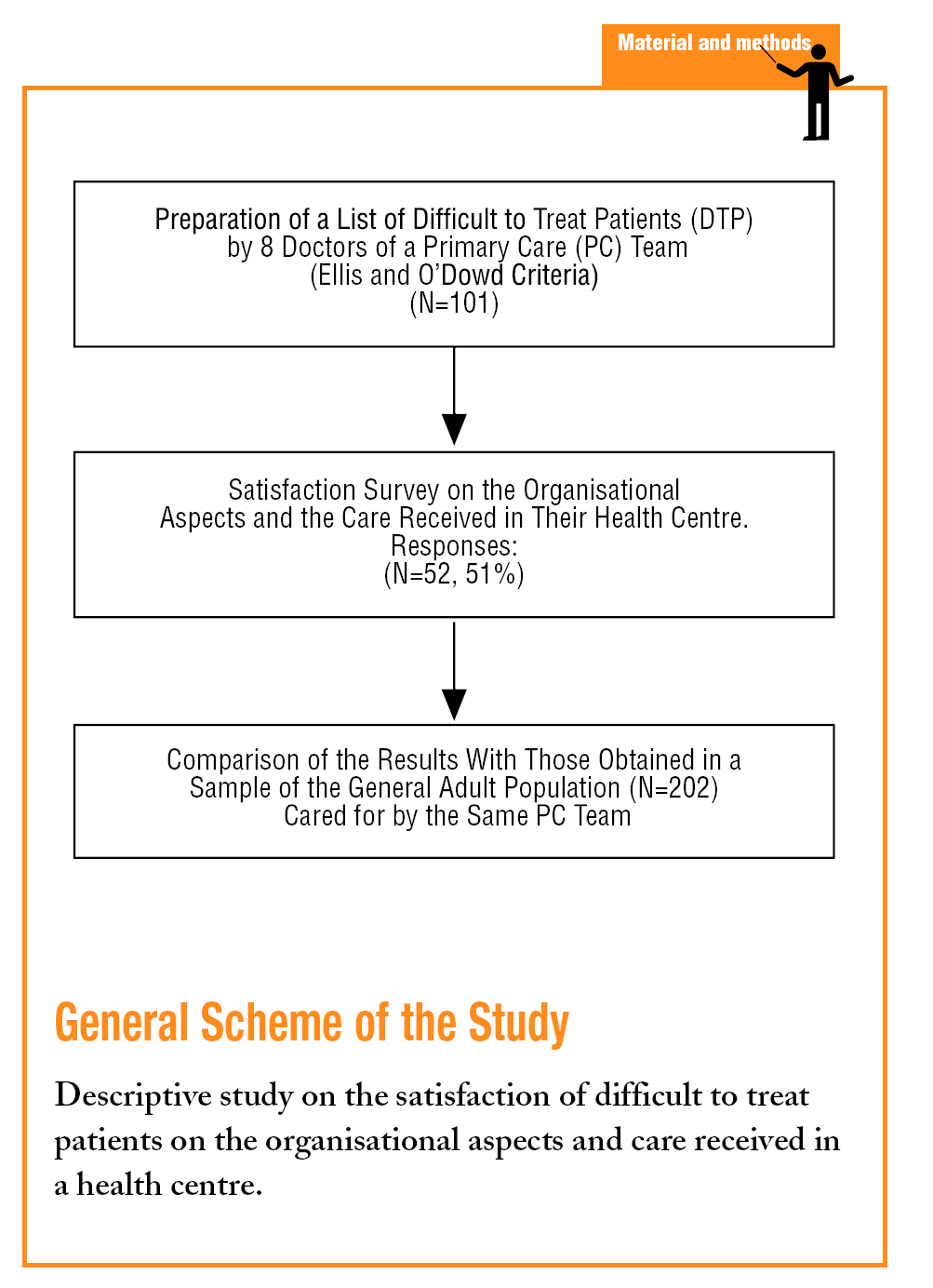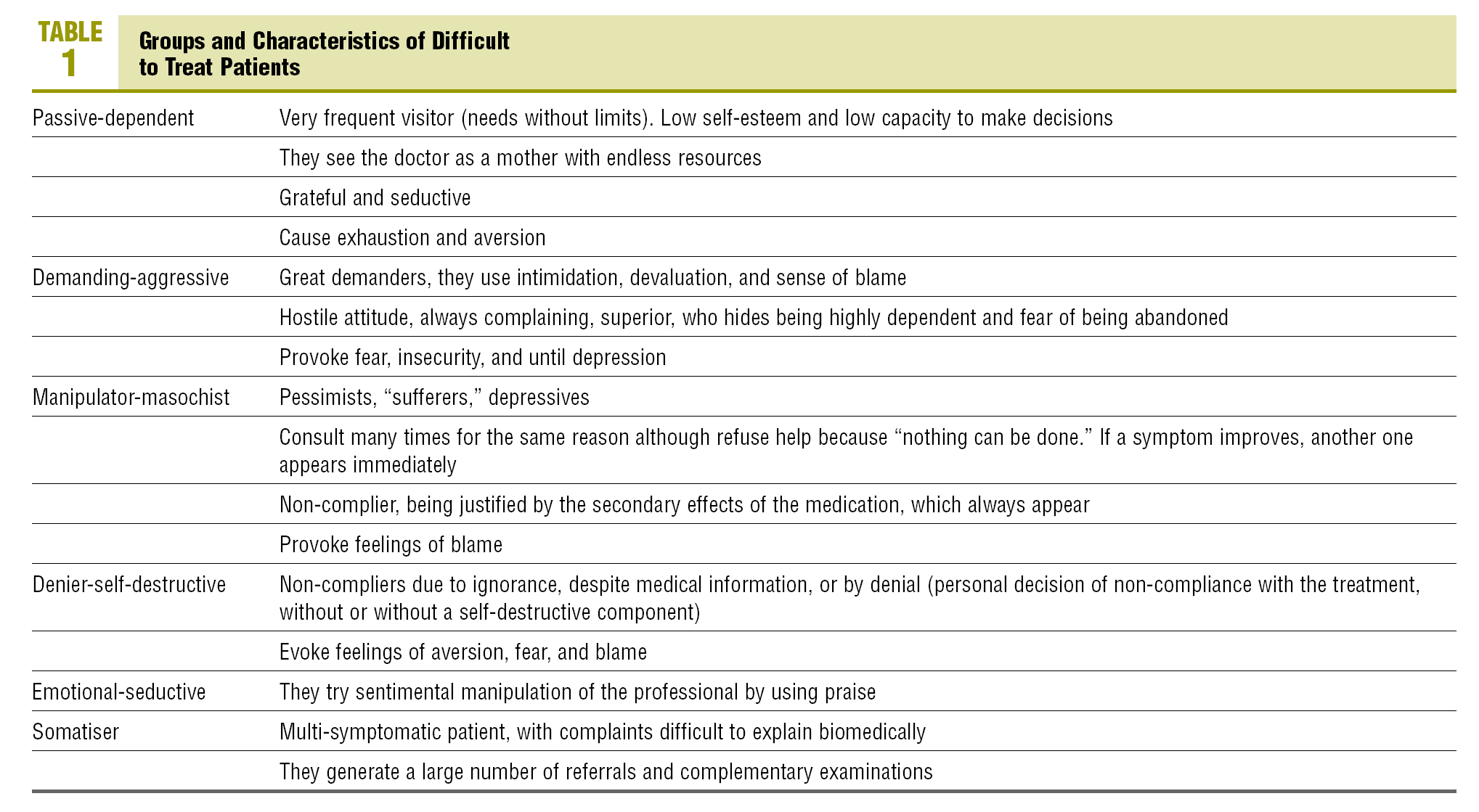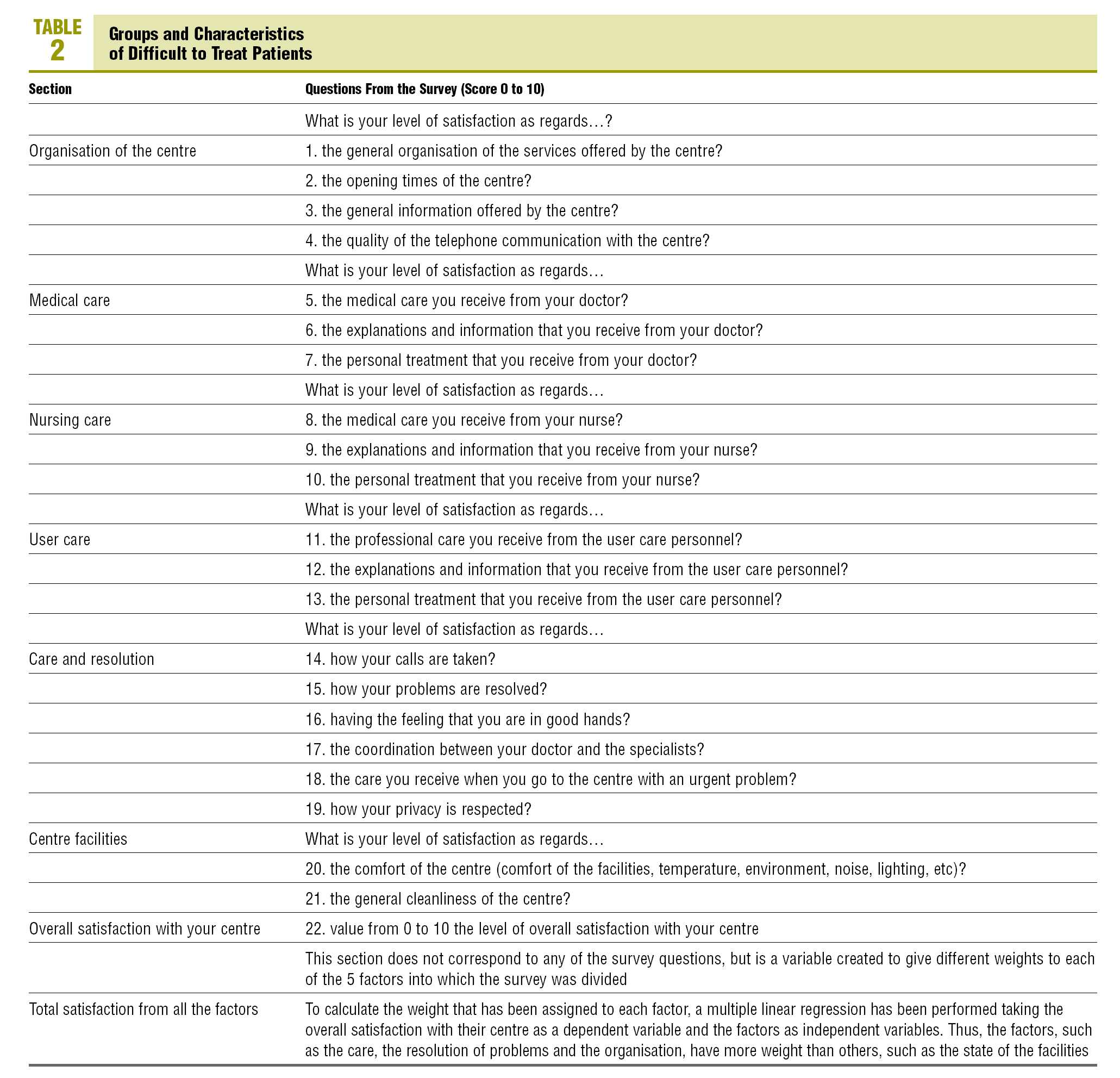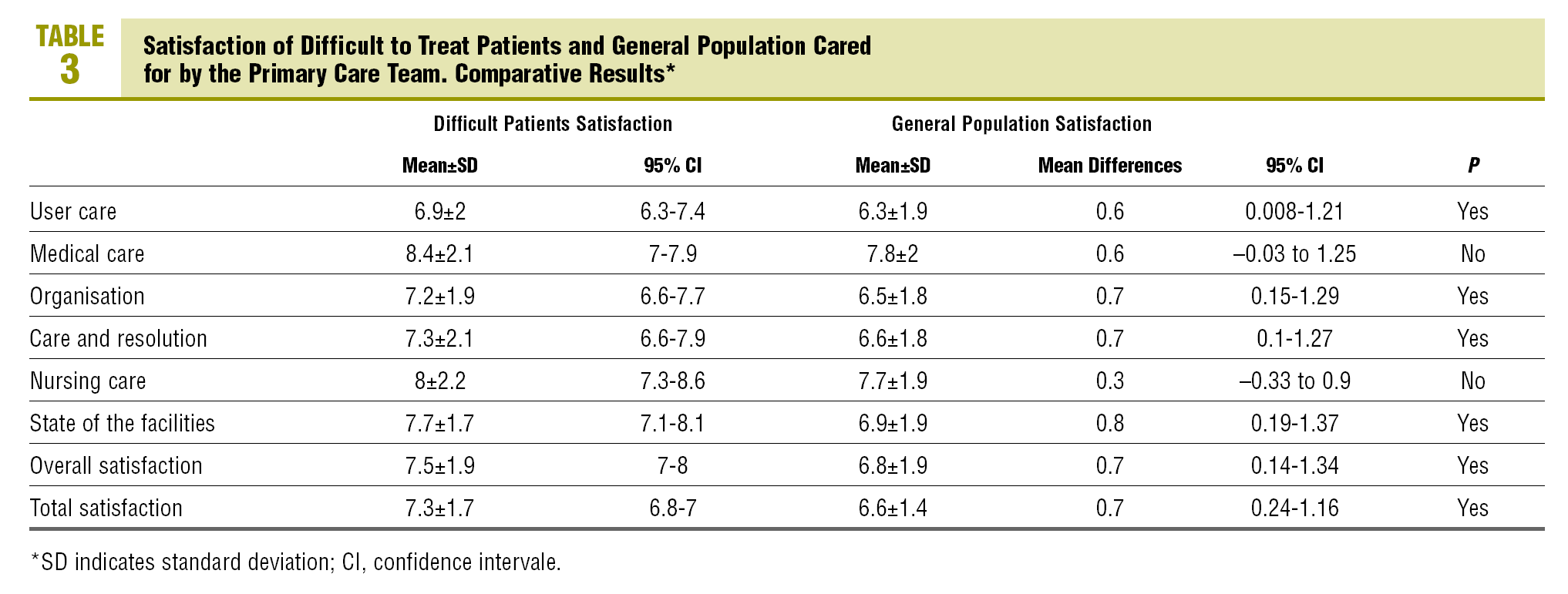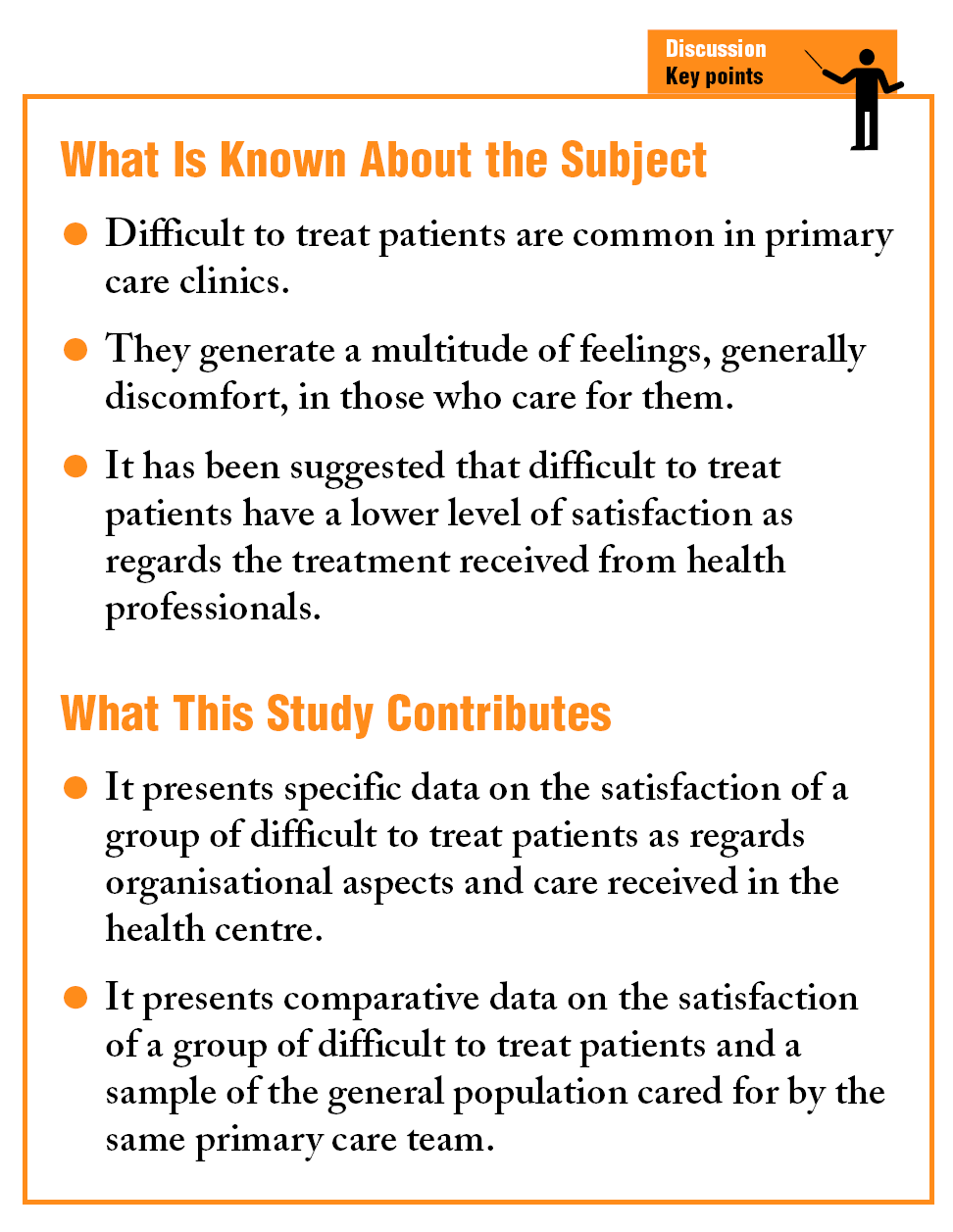Introduction
The relationships with difficult to treat patients (DTP) affect the daily clinical practice of health professionals in primary care (PC) clinics. According to some authors,1,2 it can affect up to 15%-30% of consultations. Its impact is recognised by the majority of professionals owing to its high emotional content3,4 and it has been implicated as a predisposing factor of professional "burnout."3 Since Kaufman5 coined the term "problem patient" in 1957, many different studies have been published on the profile of this type of patient and have proposed definitions,6,7 to try and establish a typology,4 to identify their common characteristics,8,9 and study the impact they have on the professionals who care for them,3,4 and propose strategies to improve relationships with them.4,6,10,11 The majority of these studies give the professional point of view. However, on few occasions it has been approached from the patient perspective and, in particular, on their expectations and satisfaction as regards the health system. Although O'Dowd,6 in 1988 had already described the feelings of the DTP on the health services, it was not until 1996 that Hahn et al12 and later Jackson et al1 in 1999, quantified the problem and reported the low satisfaction in the relationships between the DTP and health professionals.
We do not know of any study in our setting that tackles the point of view of the DTP, although Blay et al,11 in their review article, suggested differences in the level of satisfaction of DTP as regards the services they received.
The objectives of the present study are to evaluate the level of satisfaction of the DTP cared for by a Primary Care Team (PCT) as regards organisational aspects and the care received, and compare this with that obtained by a sample of the general population cared for by the same team.
Participants and Methods
Setting
Basic Urban Health Area of South Santa Eulàlia (L'Hospitalet
de Llobregat, Barcelona), with 24 000 inhabitants, and with a staff of 9 family doctors (GP) and 3 paediatricians.
Method
A descriptive cross-sectional study in which 8 family doctors from the centre took part. Six of them prepared a list of DTP patients between March and May 2003, with the objective of finding out the prevalence, and to describe their profile and look in depth at the feelings that are evoked in them.13 The patients were selected during their normal clinic appointment, using the definitions of Ellis (patients who evoke adverse feelings dysphoria on their name being read on the appointments list)7 and O'Dowd (patients capable of causing distress-stress in those who care for them)6 and classified into different character types according to criteria by Groves4: passive-dependent, demanding-aggressive, manipulators, emotional-seductive, deniers, and somatisers. The main characteristics of the different types of DTP are shown in Table 1.
At the beginning of 2004, the professionals who participated in that study were asked to update their list: the patients who had died, those who had changed their doctor, those who had difficulty filling in the questionnaire (illiterate), and those who had not attended the clinic in the previous year were removed, and other patients who complied with the inclusion criteria were added. At the same time, 2 more doctors, who had not taken part in the previous study, prepared their own list following the same criteria. Thus a new and updated list with 101 identified DTP was obtained, and who were all included in the study.
A second phase of the study to evaluate the satisfaction of the DTP was carried out between March and May 2004. It used a questionnaire, prepared and validated by the Catalonian Health Institute (ICS), which each doctor personally handed over to the selected patients, during a normal clinic appointment, after asking them if they wanted to participate in an anonymous survey on satisfaction. The questionnaire was self-completed, outside the clinic or at home, and deposited in a box situated in the centre entrance. It contained 27 questions: 22 evaluated on a scale of 1 to 10, one question which is answered on an ordinal scale (Do you consider the time you had to wait in the waiting room before being seen by the doctor/nurse as: short, acceptable, excessive?), one question which is answered on a qualitative dichotomy scale (Would you recommend your friends to come to this centre?: yes or no, and 3 open questions (best and worse valued aspects of the centre and suggestions). The questions were grouped into 8 sections for their analysis (Table 2). The only fixed data associated to the patient was their age and gender, although a code was added to identify their character type, with the objective of subsequently checking if the patients who answered the questionnaire were representative of the total of all those who were given one, since a possible low participation was predicted.
The results were compared with those obtained in the last patient satisfaction evaluation carried out in the centre by the ICS (September 2003) using the same questionnaire on a sample of 202 subjects from the general population cared for by the PC team.
Analysis
The quantitative variables are described using percentages, and the quantitative ones, using the mean ± the standard deviation (SD) with their corresponding 95% confidence intervale. Given that there was no access to the data base used to estimate the level of satisfaction of the 202 subjects from the general population, only the mean ± SD of each of the 8 sections are available. We used the CIA program (Confidence Interval Analysis) version 1.1 to estimate the 95% CI of the mean differences between the 2 groups in each of the sections.14-16
The SPSS version 10.0 statistics program was used for the rest of the analysis.
Results
A total of 101 questionnaires were given out (which was the complete list of DTP prepared by the 8 doctors): 69% women, 31% men, mean age 58±16.6 years, classification; dependent in 47%, demanding-aggressive in 21%, manipulator in 18%, emotional-seductive in 6%, denier in 18% and somatiser in 5%.
A total of 52 completed questionnaires were received (51% participation).
Two (4%) were considered void due to not having answered all the questions. The distribution of the 50 valid questionnaires was: 62% women, 38% men, mean age 61.5±12.3 years, classification; dependent in 50%, demanding-aggressive in 25%, manipulator in 11%, emotional-seductive in 8%, denier in 18% and somatiser in 2%.
Compared to the results obtained in the general population, the DTP population returned higher values in all sections, although there were no significant differences in the care provided by medical personnel and care by the nursing staff (Table 3). No significant differences were observed as regards gender.
Of the patients who responded to the questionnaire, 91,7% (95% CI, 80-97.7) would recommend the centre to their friends, and 72.9% (95% CI, 58.2-84.7) consider the time they had to wait before being seen as short or acceptable. As regards the open questions, we categorised them as proposed by Visauta et al,14 due to the low number of responses received and we only mention the most repeated ones: the higher valued aspects, are the treatment and dedication of the medical personnel, of all the staff in the centre or nursing staff, the location of the centre (proximity to home) and the cleanliness. The worst valued are the difficulties in communicating by telephone and specialised care.
Discussion
According to O'Dowd6, it is essential to obtain information and secure a better understanding of what happens to the patient, to lower the perception of difficulty during the clinic interview.6 Obviously, a way to bring us closer to the point of view of the patient is to examine their satisfaction and expectations as regards the health services that they receive. The results of the present study show that the level of satisfaction of a group of DTP cared for in PC can be considered noteworthy, with scores above 7 points on a scale of 0 to 10 in the majority of the sections studied, including the overall and total satisfaction. It even slightly exceeded that obtained in a sample of the general population in some sections. The majority of patients surveyed also stated that they would recommended the centre to their friends and in general, were satisfied with an annoying aspect, as the waiting to see the doctor can be. This data contrasts with that given by other authors: O'Dowd,6 in a study carried out in 1988, suggested that DTP seemed to be dissatisfied with the medical services received.6 However, this perception is not quantified and, in fact, in the conclusions of his study the author highlighted that only 2 of the 28 patients included openly expressed dissatisfaction, as a reason for leaving the clinic and changing their doctor. In our setting, Blay,11 in a review article, also noted dissatisfaction as a common characteristic in DTP, without giving quantified data.11 In 1996, it was Hahn et al,12 who quantified these perceptions for the first time, reporting higher levels of dissatisfaction by DTP.12 However, the evaluation of satisfaction was not carried out by validated questionnaires, but by an open question answered by the patients.
Subsequently, for the first time, in 1999, Jackson et al1 assessed the level of satisfaction associated with specific aspects of the medical encounters and reported a higher discontent as regards, explanations received, the perception, by the patient, of the competence of the doctor, and the time dedicated to the visit.1 However, this study differs from ours in aspects which we believe are fairly important: the patients are seen by the first doctor available at that time in a clinic for impromptu visits and not by their own family doctor. The evaluation of satisfaction is carried out immediately after the visit, not after a process of continual care as in our case. This fact, also recognised by the author himself, could mean that the patients may have expressed more dissatisfaction owing to not being cared for continually by their usual doctors.
The interpretation of the study by James et al4 may provide a key to the more favourable results of our study. This author stated that the passive-dependent patient, the most widely represented in our series, is grateful, or that under the intimidating appearance of the demanding-aggressive patient there lays a great dependence and a real fear of being abandoned. Therefore, these patient groups can be shown to appear satisfied. The fact that the majority of the doctors participating in our study have worked for about 10 years in the post may also make a difference, due to mutual adaptation or owing to changes of doctor, to smooth differences and improve the satisfaction perceived by the DTP.
As regards limitations, we believe the main limitation of our study is in the low percentage of patients who replied to the survey, which is also normal, in self-administered surveys sent by post or handed over personally to the patients to be returned later.17-19 We chose this latter mode to guarantee anonymity and avoid bias by the presence of the investigator. Anticipating the low participation, we wanted to assess whether the patients who responded to the survey could be considered as a representative sample of the total DTP population who were given the questionnaire, and we could rule out a participation bias attributable to the character type of the patient: we counted the different types of DTP in the list of questionnaires given out and in the questionnaires returned, with the aim of verifying whether all the DTP types where represented within those who responded to the survey. In the results obtained, we did not see any large differences between the percentages of the different DTP types when comparing the 2 lists. Patients from all the groups (including the most difficult (demanding-aggressive, had responded to the questionnaire, with a distribution similar to that in the list of questionnaires handed out.
We do not know the response rate as regards the participation in the survey of the general population. We do know that it was 78.6% in a pilot study carried out in 2002, but we cannot extrapolate these results to our case due to it being from different populations. On the other hand, the questionnaires were handed out and collected by administration staff in the waiting rooms of the centre, a fact which could explain the higher participation as compared to the DTP population.
We believe that the tool used to measure the satisfaction has the necessary requirements to make it valid: previous validation and adapted to the objectives of the study: previous validation, assessment of multiple sections of satisfaction associated with different aspects of the services received in a PC health environment, guarantee of anonymity (although it is possible that the fact that the doctors handed over the questionnaires to their own patients could have caused a relative bias in the responses) and reproducibility. It has also allowed the results to be compared with those obtained in a sample of the general population of the basic health area, which was used as a control group. Although the survey was carried on the general population and DTP in different periods (September 2003 and March to May 2004, respectively), we believe that this has not resulted in a significant bias, owing to the fact that the conditions in which the 2 groups were seen did not vary substantially in this period: no physical changes were made in the health centre, the professional staff or in the organisational structures of the PC team which, in our opinion, could influence the satisfaction of the patients.
Other authors used different DTP selection criteria to ours: Lin et al20 asked the professional to classify the patient visit into satisfactory, average or frustrating. Jackson et al,1 Hahn et al12 and Walker et al21 used the DPRQ (difficult doctor-patient relationship), prepared and validated by Hahn himself in the hospital setting and which refers more to difficult consultations than to DTP (perceived clinical difficulty of the consultation).22 We used the descriptions by Ellis7 and O'Dowd,6 since we worked with them in a previous study13 and, although less objective, they were accepted by all the participants as its contents were adapted to the real situation and due to being reproducible between health professionals.
We believe that the principle ethics of research with surveys have been followed in our study, due to the participation being voluntary, the anonymity (absence of data of association in the questionnaire, treatment of the data by only 2 researchers), the use of the same survey in the general population, and the use of the data for scientific interest and limited to the specified investigation.
Conclusions
This group of DTP is highly satisfied (more than expected) with the health centre. This suggests that the difficulties in the relationships with DTP do not necessarily cause a deterioration in the quality of care perceived by them.
The data shown can be considered as an indicator of the point of view of the DTP on the health services, as well as on the possibilities of improving our relationships with them. Conscious of the possible prejudices towards this group of patients by the health professionals (after all, it is us who, unilaterally, label them as "difficult to treat"), which includes the perception of dissatisfaction and which can make the interview worse and difficult, we believe that the positive data of this study can help to partly overcome these prejudices and to be taken advantage of as motivation to change the position of the health professional towards improving our relationships.
Finally, we believe that this study must be widened with a larger number of patients and which must also approach other aspects as regards the point of view of the patient, particularly, those proposed by Matters et al23 or Jewell et al,24 as to what extent the professionals may be the cause of the relationship difficulty. Although it might make us uncomfortable, by just knowing these hidden factors we could move towards improving relationships with patients in difficult situations.
Agreements
To M.M. Forés, J.A. Hernández, F. Millet, J. Monedero, R. Viñas, and I. Zamora, fellows in the EAP Santa Eulalia Sud for collaborate in the study. To F. Flor, health technician of the center, for his help with the methodological techniques.
Spanish version available at
www.atencionprimaria.com/119.342
A commentary follow this article
(pág. 198)
Family and Community Medicine, ABS Santa Eulalia Sud, L'Hospitalet de Llobregat, Barcelona, Spain.
Correspondence: X. Mas Garriga.
Amadeu Torner, 63. 08902
L'Hospitalet de Llobregat. Barcelona. España.
E-mail: 22716xmg@comb.es
Manuscript received 16-6-2005.
Manuscript accepted for publication: 14-12-2005.







